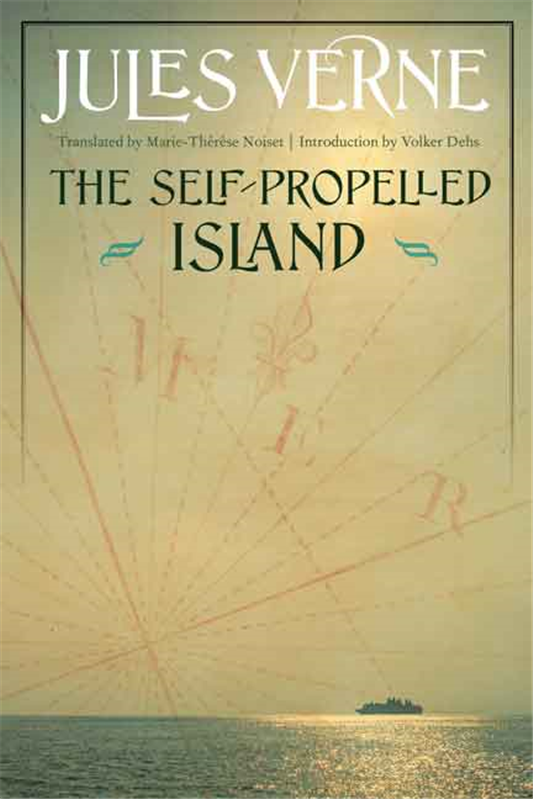The Self-Propelled Island
Propeller Island
The Floating Island
L’Ile à hélice (1895)
Member Andrew Nash’s website contains all the English title variations.Plot Synopsis:
(courtesy of member Dennis Kytasaari’s - website)
A French string quartet (Sébastien Zorn, Frascolin, Yvernes and Pinchinat), traveling from San Francisco to their next engagement in San Diego, is diverted to Standard Island. Standard Island is an immense man-made island designed to travel the waters of the Pacific Ocean. The wealth of residents of the island can only be measured in millions. The quartet is hired to play a number of concerts for the residents during their tour of the islands (Sandwich, Cook, Society, etc.) of the South Pacific. The island seems an idyllic paradise; however, it is an island divided in two. The left half’s population is led by Jem Tankerdon and is known as the Larboardites. The right half’s population is led by Nat Coverley and is known as the Starboardites. Despite the obstacles encountered on their journey, the two parties have a disagreement that threatens the future of the island itself.
Review(s)
The Self-Propelled Island (Bison Frontiers of Imagination)
Translator: Marie-Thérèse Noiset (Translator), Introduction: Volker
Dehs.
Lincoln, Nebraska. University of Nebraska Press, 2015. 352 pages, 0 ill.
Hardcover — ISBN-10: 0803245823, ISBN-13: 978-0803245822
Softcover — ISBN-10: 0803276710, ISBN-13: 978-0803276710
“We’re in the midst of a marvelous Verne renaissance. . . . The Self-Propelled
Island is a novel of great appeal, especially to Americans: by sending northern
and southern aristocrats to sea in literally the same boat, it not only features
one of Verne’s fabulous futuristic vehicles but also unfolds one of his shrewdest,
wittiest political satires.”
-- Review by Frederick Paul Walter, Verne translator and former vice president of
the North American Jules Verne Society
review of 14 Sep 2014 as shown on Amazon, it appears on the back cover of
this edition’s dustjacket
The significance of Marie-Thérèse Noiset’s new translation of Verne’s The
Self-Propelled Island (in French L’Île à hélice, previously translated as The
Floating Island and Propeller Island)—the story of four musicians aboard a
luxurious artificial island cruising the South Pacific—can perhaps best be
understood if we compare it to a Routledge reprint of the 1896 public-domain
translation of this novel that I reviewed in 1992:
This translation is severely abridged, and almost all the passages excised from Verne’s original French text happen to be in some way or another critical of England and/or the English people….Before Noiset’s translation, the only available English-language version of this novel was the horridly bowdlerized one described above and an even more chopped-down version (the “Fitzroy” edition) published in 1961.
Given this massive tampering with Verne’s original novel, it seems highly ironic that the publisher of this book—in an obvious attempt to hype this modern repackaging of a very old, very bad translation—tries to advertise Jules Verne as “a social satirist whose work has been compared to that of Montesquieu, Swift and Voltaire”….
To summarize, a revised and more accurate English translation of Verne’s L’Île à hélice would have been genuinely welcome and would have done honor to any publisher. In contrast, this book brings shame: it represents a commercialized resurrection of a translator’s travesty, and it aptly demonstrates how an industry’s profit motive can sometimes overpower its sense of literary integrity. (“New and Recycled” 262)
There is much to like in this new Verne translation by Noiset. The fine art
of translating—blending textual faithfulness with discursive fluidity—is clearly
evident in her prose. And the book’s introduction by reputed Verne scholar
Volker Dehs is both accurate and insightful. The only drawback to this
otherwise commendable book is its regrettable lack of illustrations; the original
French octavo edition featured some eighty marvelous illustrations by Léon
Benett (1839-1917), an artist whose work graced the pages of more than two
dozen of Verne’s Extraordinary Voyages.
WORKS CITED
Evans, Arthur B. “New and Recycled Translations of Jules Verne.” Science Fiction Studies 19.2 (Jul 1992): 261-63.
Evans, Arthur B. “New and Recycled Translations of Jules Verne.” Science Fiction Studies 19.2 (Jul 1992): 261-63.
-- Excerpted from Arthur B. Evans, “Culminating a Decade of Scholarship on Jules Verne,” Science Fiction Studies, 42.3 (Nov 2015): 560-61.
review obtained 26 Oct 2015
The Floating Island
Trans: Unknown. London and NY: Kegan Paul International (Routledge, Chapman & Hall),
1991. xvii+352.
Softcover — ISBN-10: UNKNOWN, ISBN-13: UNNKNOWN
NOT RECOMMENDED (read why below)
Given this massive tampering with Verne’s original novel, it seems highly
ironic that the publisher of this book—in an obvious attempt to hype this
modern repackaging of a very old, very bad translation—tries to advertise
Jules Verne as “a social satirist whose work has been compared to that of
Montesquieu, Swift and Voltaire. Today he is recognized as one of the most significant
writers and social commentators of modern times” (back cover). Insofar as
I am aware, this is the first time Verne has ever been classified as a famous writer
of social satire, and comparable to Voltaire no less! But, even worse, to characterize
him as such from this outrageously truncated translationis more than simply (and
sadly) ironic, it is insulting both to Verne and to any knowledgable reader’s
intelligence.
To summarize, a revised and more accurate English translation of Verne’s L’Île
à hélice would have been genuinely welcome and would have
done honor to any publisher. In contrast, this book brings shame: it represents
a commercialized resurrection of a translator’s travesty, and it aptly demonstrates
how an industry’s profit motive can sometimes overpower its sense of literary
integrity.
 © 1993 - 2025 North American Jules Verne Society, Inc. — a 501(c)(3) Corporation
© 1993 - 2025 North American Jules Verne Society, Inc. — a 501(c)(3) Corporation
